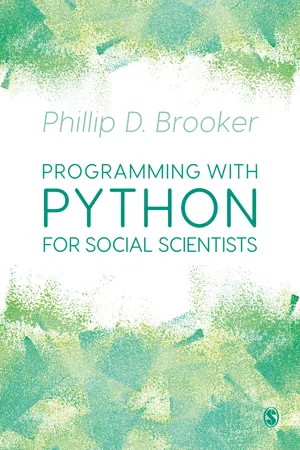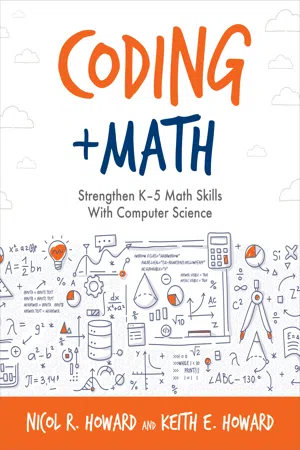Computer Science
Python Comparison Operators
Python comparison operators are used to compare two values and return a Boolean result. Common comparison operators include == (equal to), != (not equal to), > (greater than), < (less than), >= (greater than or equal to), and <= (less than or equal to). These operators are essential for making decisions and controlling the flow of a program based on different conditions.
Written by Perlego with AI-assistance
5 Key excerpts on "Python Comparison Operators"
Learn about this page
Index pages curate the most relevant extracts from our library of academic textbooks. They’ve been created using an in-house natural language model (NLM), each adding context and meaning to key research topics.
- Yasha Hasija, Rajkumar Chakraborty(Authors)
- 2021(Publication Date)
- CRC Press(Publisher)
Until this point, we have recognized our programs as straightforward, but these did not seem to be smart, nor did these make any decisions. If we want a program to make decisions based on some conditions, then it will require conditional statements. Computers have only two conditions - “True” or “False” - similar to a light switch that has two conditions - “On” or “Off”. Therefore, these “True” and “False” conditions constitute a particular datatype in Python referred to as Booleans.Defining a condition always requires some kind of comparison - such as greater than, less than, or equal to. Some of the comparisons with their operators in Python are given below:All of these comparisons result in the Boolean values “True” or “False”.• Equal: a = = b• Not Equal: a!= b• Less than: a < b• Less than or equal to: a < = b• Greater than: a > b• Greater than or equal to: a > = bCode:#Booleans expressions and comparisons # Comparing integers print(100 = =100) print(100 = =101) print(200 > 100) print(200 < 100) # Comparing strings print('hello'=='hello') print('hello'=='hey') print('hello'!='hey')Output:True False True False True False TrueWe can compare any datatype in Python - including comparisons between integers and strings - as illustrated in the example above. In the output, we have “True” and “False”. These are not a string of characters; rather, they are predefined keywords of Python and are of the bool type.Code:# True and False are not strings, they are bools print(type(100 = =100)) print(type(100 = =101)) print(type(True)) print(type(False))Output:<class 'bool'> <class 'bool'> <class 'bool'> <class 'bool'>Logical Operators
When we have to compare multiple conditions, we have to use a logical operator. Python has three logical operators - “and”, “or”, and “not” - their meanings in the Python program are the same as their definitions in English. Usually, logical operators operate on the following conditions:- eBook - ePub
- Phillip D. Brooker(Author)
- 2019(Publication Date)
- SAGE Publications Ltd(Publisher)
10 #on social science applications for more detail). This becomes especially- 11 #powerful when we combine it with things like IF, ELIF and ELSE statements
- 12 #(which we will do later), but for now, here are a list of ways in which
- 13 #we can compare things in Python. I have declared three variables below -
- 14 #try typing the comparisons I've listed into the Python shell and see what
- 15 #happens.
- 16
- 17 a = 2
- 18 b = 3
- 19 c = 4
- 20
- 21 a == b #The double-equals signifies an "is the same as" comparison.
- 22 a != b #This signifies a "not the same as" comparison
- 23
- 24 b > a #"is greater than"
- 25 b >= a #"is greater than or equal to"
- 26
- 27 b < a #"is less than"
- 28 b <= a #"is less than or equal to"
- 29
- 30 c % a #This is called the "modulo", which effectively means the remainder.
- 31 #So here, the value that will be given when you type this into the Python
- 32 #shell will be the remainder that is left over when c is divided by a. The
- 33 #modulo is more of a calculation than a comparator, but it's mainly
- 34 #only relevant to us as a way of comparing things.
- 35
- 36
- 37 #QUESTION: You can also do calculations within comparisons. Can you guess what
- 38 #will result in the following cases? Have a guess, then type them into the
- 39 #Python shell to check.
- 40
- 41 a+1 == b
- 42
- 43 c-1 >= b
- 44
- 45 c/4 > a
- 46
- 47 a*2 == c
- 48
- 49 c % a == 0
It’ll be good to note at this point that though the modulo operator/comparator might not immediately come across as having much use, it can come in handy in various ways as we start to build more complicated programs. So, it’s worth bearing in mind going forward. - eBook - ePub
- Joy Ko, Kyle Steinfeld(Authors)
- 2018(Publication Date)
- Routledge(Publisher)
operators.COMPARISON OPERATORS scr 1.037Logical Operators
Like comparison operators, the logical operators (and, or, not) also evaluate to be True or False. A chain of expressions connected by these are evaluated from left to right, and evaluation stops when truth or falsehood is ascertained. These are tabulated in Table 1.04 .LOGICAL OPERATORS scr 1.038Decomposing An Expression
Just as in mathematics, expressions in code are evaluated in the order specified by the precedence rules of the language. In mathematics, this is termed the order of operations** , as may be demonstrated by an example that relies on familiar operations. Consider the expression 1 + 1 == 2. First, the three numeric literals are converted into the appropriate objects, represented here by our symbols for the Python number type.Applying the precedence order outlined above, we can see that the arithmetic operator (+) should be evaluated before the comparison operator (==). This reduces the expression to 2 == 2.That leaves just one operator remaining, which reduces things down to just a single object, the Boolean value True.To move beyond this simple example to one that involves a more complete account of literals, variables, function calls, and operators, we’ll need to be a bit more explicit about the evaluation order of not just arithmetic operators, but of the implications of enclosures and method calls as well. Below is just such an explicit description of the order of evaluation taken by the Python shell. We may apply this description to produce diagrammatic representations of the evaluation of expressions, as demonstrated in the slightly more involved script here, as well as a modification of our Mathematical Monsters example which follows. - eBook - ePub
Coding + Math
Strengthen K–5 Math Skills With Computer Science
- Nicol R. Howard(Author)
- 2020(Publication Date)
This chapter explains how math operators are used in CS and what similarities and differences exist between the two disciplines. The chapter also explores loops and how they function in programming.Included in this chapter:• Project using the tool Flowgorithm to create loops• Comparison of loop function across programs• Resources for deeper exploration of operators and loopsOperators
Knowledge of basic math operators transfers effectively to a programming environment due to the fact that their use in coding mirrors their frequent use in math learning. Addition and subtraction use the same symbols (+, –) and operate for the most part just as they do in standard math exercises. Multiplication and division use different symbols than students may be used to (* and / rather than x and ÷, respectively), but otherwise operate the same as students have become accustomed to using them. Likewise, relational operators (e.g., <, >, =, >=, <=) appear and behave exactly as they do in elementary math textbooks and commonly encountered exercises. Students can build confidence in their programming skills while strengthening their math proficiency by programming tasks that utilize these skills in solving problems or executing tasks that require them. This can provide relevance to skills that are sometimes learned in isolation, which can enhance students’ motivation to increase math proficiency as well.The use of the equals sign (=) can cause some confusion for the novice programmer, as it is interpreted differently in code. In math, a = 4 means the two are equal, as in a is already equal to 4. In programming, the equals sign (=) is an assignment operator rather than part of an existing equation. In programming, a = 4 is interpreted as “let a = 4” and is used to assign values to variables. If I then wanted to change the value of variable a to 6 in a code statement, I could add to the current value of variable a by writing “a = a + 2”, which simply adds 2 to the current value of a (4) to make it 6. Alternately, I could overwrite the old value by writing “a - eBook - ePub
Bioinformatics Algorithms
Design and Implementation in Python
- Miguel Rocha, Pedro G. Ferreira(Authors)
- 2018(Publication Date)
- Academic Press(Publisher)
In Python, the data type is not defined explicitly and it is assumed during the execution by taking into account the computation context and the values assigned to the variable. This results in a more compact and clear code syntax, but may raise execution errors, for instance when the name of a variable is incorrectly written or when non-operations are performed (e.g. sum of an integer with a string).2.2.2 Assigning Values to Variables
In Python, the operator=is used to assign a value to a variable name. It is the core operation in any computer program, that allows to define the dynamics of the code. This operator is different from==, that is used for a comparison between two variables, testing their equality.Therefore, following the syntax: varname=value, the variable named varname will hold the corresponding value. The right side of an assignment can also be the result of calling a function or a more complex expression. In that case, the expression is evaluated before the corresponding resulting value is bound to the variable.When naming variables composed by multiple words, boundaries between them should be introduced. In this book, we will use the underscore convention, where underscore characters are placed between words (e.g. variable_name).We will use the interactive mode (shell) to look in more detail on how to declare variables of the different built-in types and what type of operations are possible on these variables.Python allows variables to have an undefined value that can be set with the keyword None . In some situations, it may be necessary to test if a variable is defined or not before proceeding.If a variable is no longer being used it can be removed by using the del clause.2.2.3 Numerical and Logical Variables
Numeric variables can be either integer, floating point (real numbers), or complex numbers. Boolean variables can have a True or False value and are a particular case of the integer type, corresponding to 1 and 0, respectively.Multiple variables can also be assigned with the same value in a single line: Multiple values can be assigned to different variables in a single instruction, in the order they are declared. In this case, variables and values are separated by commas: Assignments using expressions in the right hand side are possible. In this case, the evaluation of the expression follows the arithmetic precedence rules.




